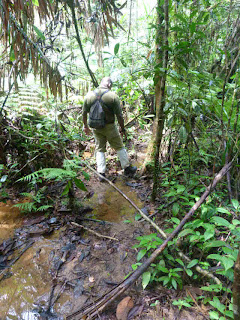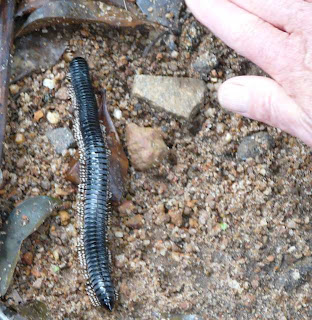I had a fairly
ordinary nights sleep, possibly being a little dehydrated and not
having a big enough pillow. Of course at dawn I was solidly asleep and as a result I was
not up early enough to see the Sri Lankan Blue Magpies come to feed
on moths in the breakfast area. I did get a good look at the rainforest however ....
... and a Junglefowl came to visit.
The place is quite well set up as an eco lodge with solar hot water and his own mini hydro-electric scheme. It is certainly 'simple' but is also very close to the forest and wildlife (which is the reason for coming here) and all other accommodation is at the foot of the hill about 40 - 60 minutes jeep drive away. Surprisingly for such a remote place there was good cellphone coverage. Perhaps Telstra should send a mission to Sri Lanka to work out how to do it? (See below more significant comment on this!)
... and a Junglefowl came to visit.
The place is quite well set up as an eco lodge with solar hot water and his own mini hydro-electric scheme. It is certainly 'simple' but is also very close to the forest and wildlife (which is the reason for coming here) and all other accommodation is at the foot of the hill about 40 - 60 minutes jeep drive away. Surprisingly for such a remote place there was good cellphone coverage. Perhaps Telstra should send a mission to Sri Lanka to work out how to do it? (See below more significant comment on this!)
As no-one had been
able to acquire bread yesterday our breakfast included coconut roti:
while it looked a bit like dwarf bread (which is inherited not baked)
it tasted excellent. It was enhanced by application of Woodapple
jam.
The aim of the day
was to walk up and down the road to the Research Centre and visit a couple of other places of interest.
The first of these was to try to locate the Serendib Scops Owl. We
failed, but did find a beautiful green pit viper under a bank.
The other snake species seen on this day was a Keelback. Nowhere near as attractive or venomous.
As we walked out to the Centre we found some Malabar Trogons. I really like this genus: like parrots but "softer". Unfortunately they stayed out of camera range. Several of the other endemics were located until we found a gang/family of Sri Lanka Blue Magpies.
It seems that several of the guides feed them at this point, including one bloke who turned up with two German clients. He had the Magpies feeding off the top of his telescope.
As we walked out to the Centre we found some Malabar Trogons. I really like this genus: like parrots but "softer". Unfortunately they stayed out of camera range. Several of the other endemics were located until we found a gang/family of Sri Lanka Blue Magpies.
It seems that several of the guides feed them at this point, including one bloke who turned up with two German clients. He had the Magpies feeding off the top of his telescope.
This group ended up
at the Centre at the same time we did. Then their equivalent of
Chandra turned up to say he had found the Sri Lanka Frogmouths. The
guide counselled his female client that it would be muddy getting
there and that if a leech got her she wasn't to scream as it would
scare the froggies. She immediately found a leech on her and
screamed which scared the pants off all of us and caused her spectacles to crash to the ground. It was a bit of a
struggle getting to the Frogmouth position and very muddy.
Note the white 'spats': they are in fact leech socks which seem to deter the little beasts from going up your leg. They have other ways in however so constant vigilance is required.
The Frogmouths (an endemic species) were a lot smaller than our home crew and very cute.
Note the white 'spats': they are in fact leech socks which seem to deter the little beasts from going up your leg. They have other ways in however so constant vigilance is required.
The Frogmouths (an endemic species) were a lot smaller than our home crew and very cute.
At least the
Germans were interested in Nature. We saw a Pommie couple who looked
very miserable (and totally inappropriately dressed). This was not
improved by the large patch of blood on the female's backside where a
leech had obviously had a good feed. Two other large groups charged
through – one set of Pom blokes wearing shorts and a group of
Russian females, some of whom at least were wearing jewel enhanced
thongs – in a rain forest!!!
There were a lot of orchids around. One species (unidentified) was called 'ground orchid' ...
... while the other, shown in close up yesterday, was Arundina graminifolia was rather tall!
Eat your heart out, Little Dumpies!
Also of interest in the plant department were some Pitcher Plants. We could distinguish two species, the first of which was quite tall ...
... while the second was low, almost on the ground.
We had also enjoyed the masses of butterflies around of which two of the smaller species seemed to take a liking to my shoes.
There were a lot of orchids around. One species (unidentified) was called 'ground orchid' ...
... while the other, shown in close up yesterday, was Arundina graminifolia was rather tall!
Eat your heart out, Little Dumpies!
Also of interest in the plant department were some Pitcher Plants. We could distinguish two species, the first of which was quite tall ...
... while the second was low, almost on the ground.
We had also enjoyed the masses of butterflies around of which two of the smaller species seemed to take a liking to my shoes.
Three-spot Grass-yellow
Angled Pierrot
They were easy to photograph while some of others were impossible. We particularly liked the Tree Nymphs - large, back and white beasts that floated like something out of Avatar! Butterflies will have a separate summary page.
I enjoyed this monster snail
... and this attractive spider species popped up at various points throughout the trip.
A few other
arthropods were also of interest, especially the millipedes. These
were a contender for pattern of the day. Rob took the snap, and marvelled that anyone - in this case Frances obliged - would put their hand in that close for scale.
I also liked the shapes made by the vicious thorns on this rattan palm.
I also liked the shapes made by the vicious thorns on this rattan palm.
We had walked
halfway back to the Lodge when a flock came through so beetled off to
look at it. A Red-faced Malkoha was found as part of theflock: very
pleasing as our trip was based on a Jetwing standard “Malkohas and
Leopards” outing. We then went back to the Research Centre. While
there we noticed the cloud building up again and sure enough got wet
again. Taking off my leech socks and checking my clothes and body I found I had
carted 10 leeches back to the Lodge. Yecccch!
Bird of the Day: Malabar Trogon (the Magpies were semi tame)
Other Vertebrate of the Day: Green Pit viper
Pattern of the Day: Can't remember!!
Bad taste of the Day: Bejewelled thongs on Russian tourists.
Read on
Bird of the Day: Malabar Trogon (the Magpies were semi tame)
Other Vertebrate of the Day: Green Pit viper
Pattern of the Day: Can't remember!!
Bad taste of the Day: Bejewelled thongs on Russian tourists.
Read on


















Are you saying that "Leech Socks" don't work?
ReplyDeleteI was thinking of commissioning you to get me a pair.
I have heard great things about them from my Millipede expert friend, following his trip to Thailand.
Denis
I have emailed Denis to say that they don't work infallibly. Thy do make it easier to detect and deal with the ones that attack from ground level, but vigilance is required to knock them off. And others come in at chest height from the bush, and no sock is going to stop them. Images will be offered later!
Delete